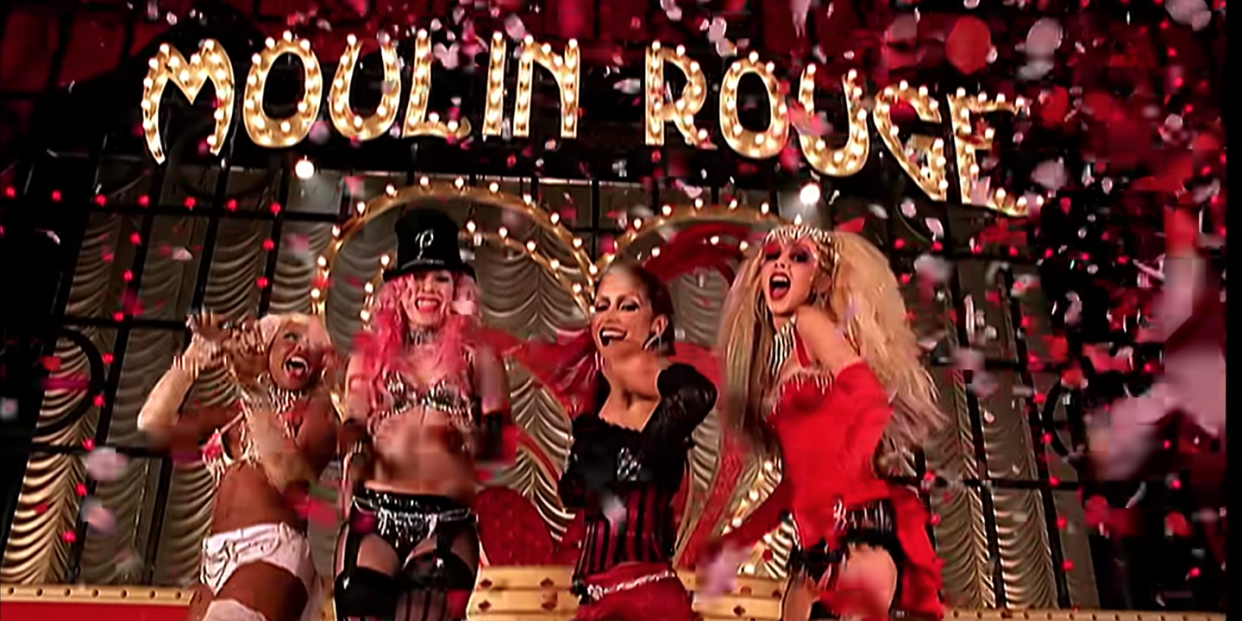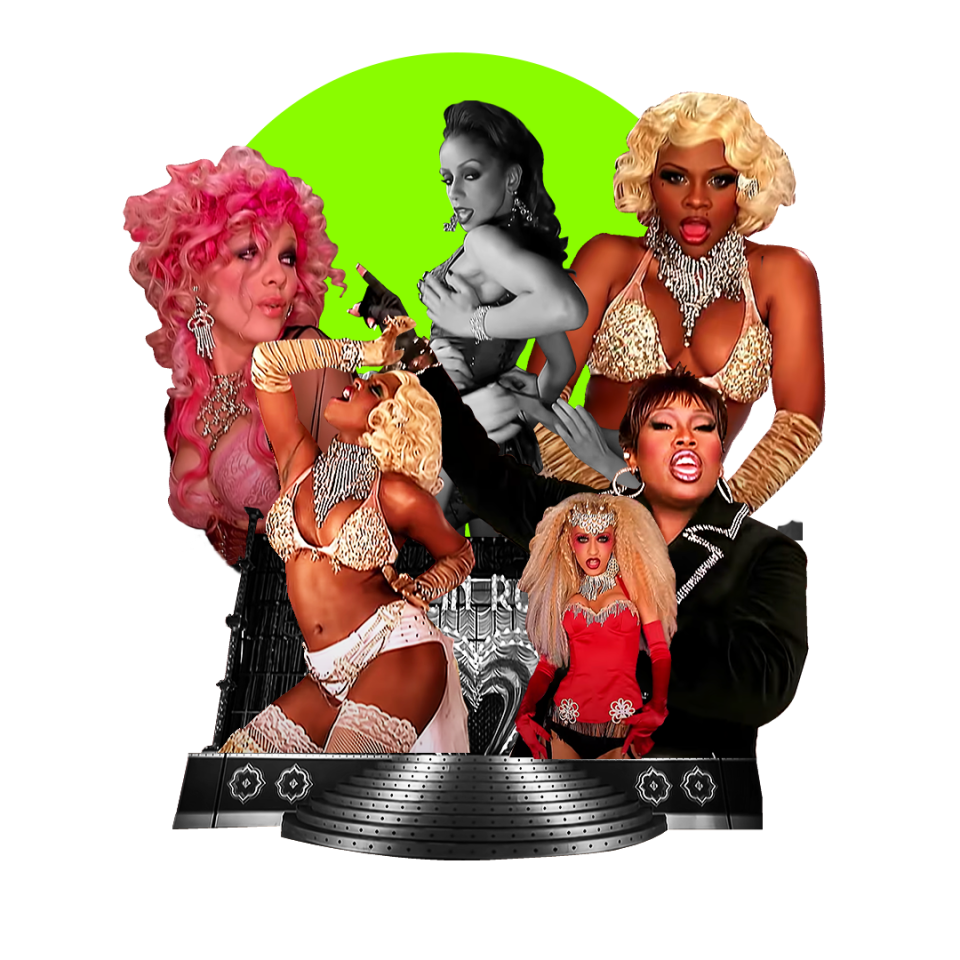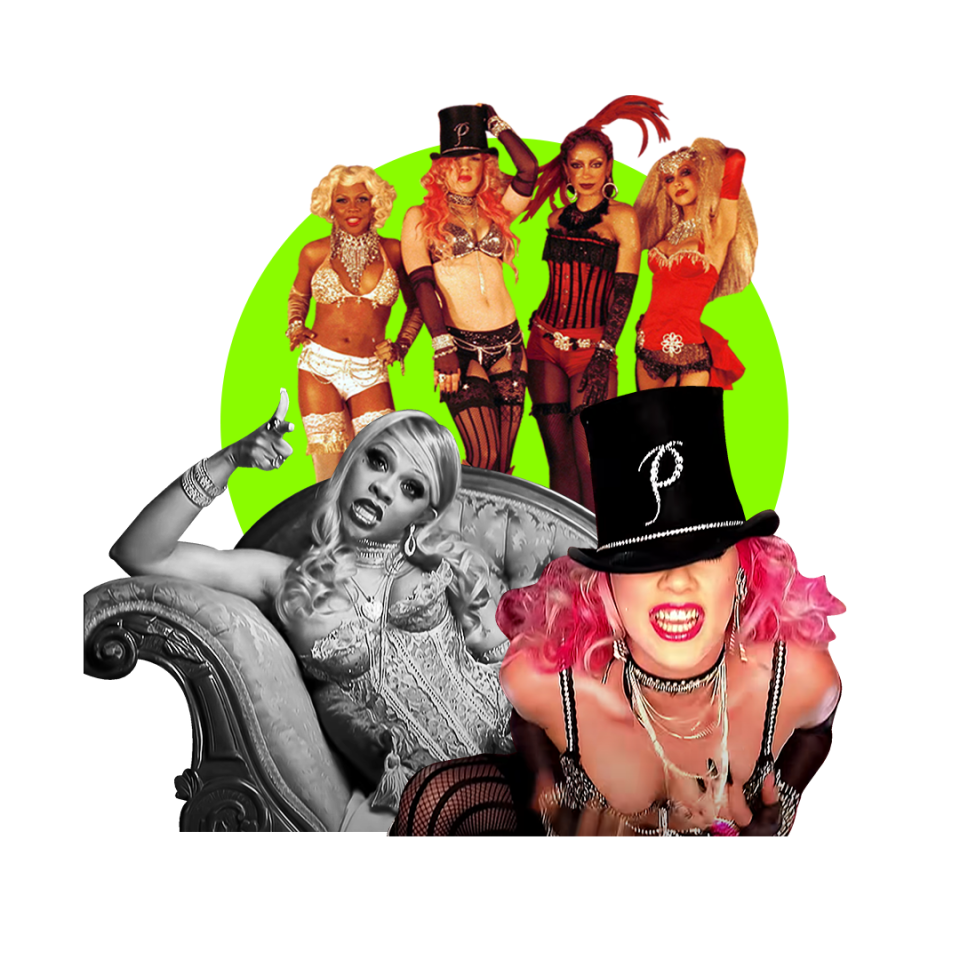Christina Aguilera, Missy Elliott, and Mýa Break Down Alllll the Drama Behind the “Lady Marmalade” Music Video, 20 Years Later

- Oops!Something went wrong.Please try again later.
- Oops!Something went wrong.Please try again later.
Cue a sepia-tone montage of you, keeping MTV on in the background *just in case* the song came on, cranking the volume whenever it did, and asking Jeeves for the translation of “Voulez-vous coucher avec moi, ce soir?” so you could cheekily work it into an AIM away message. Because this wasn’t just a song from the movie Moulin Rouge! or a cover of Patti Labelle’s 1974 classic. It was A Moment—with big hair, bigger voices, and even bigger personalities—that was really about power. More specifically, about women (in this case, the lingerie-clad, jewel-covered Mýa, Lil’ Kim, Pink, and Christina Aguilera) reclaiming their power as unapologetically sexual beings. The groundbreaking collab become a viral hit before viral hits were even a thing and is still going strong, btw—“Lady Marmalade” has 384 million YouTube views and counting, artists and the internet alike continue to pitch dream castings for a(nother) remake, and, yeah, it’s probably stuck in your head right now.
When Patti LaBelle originally recorded “Lady Marmalade” with her girl group Labelle in 1974, “we knew right away it was a hit,” she tells Cosmo. (She was right: It reached number one on the Billboard Hot 100, stayed on the charts for 18 weeks, and helped tee Patti up for a decades-long solo career.) So this time around, when Baz Luhrmann’s big-budget Oscar-bait film was on the hunt for a standout song, record label exec Ron Fair and producers Missy Elliott and Rockwilder had huge shoes to fill. Failure to repeat the original chart-topper’s success was not an option.
Missy Elliott (coproducer): Labelle’s original version was a song we had all loved growing up, and we saw it as a kind of honor to put our own spin on it. We wanted to showcase each of the “four badass chicks from the Moulin Rouge,” bringing together their different skills and personas into a true celebration of diversity, talent, and female unity.
Mýa (singer): I got the request to be on the song—Jimmy Iovine, who was the head of Interscope Records at the time, suggested that my participation would be a great addition for multicultural appeal. “Lady Marmalade” is inclusive to all genres, races, ages. Pink had more of the rock and roll and alternative aspect happening. Christina had pop. I had the R&B, hip-hop thing. Kim was rap all the way. Missy was a full-on entertainer, and Patti LaBelle, she’s like a godmother to us and just a woman full of wisdom.

Christina Aguilera (singer): I think we all brought something unique to the table. The message was awesome, because every woman wants to feel good in their own skin. Every woman wants to own their sexuality—whether you want to put on a corset or not. Before, to be sexualized meant that you would be labeled, and to own your sexuality meant you would be slut-shamed. As soon as I heard Missy and Rockwilder’s production, it was just like, “This is going to be something that feels so good and so right.”
In early 2001, the four singers recorded their vocals separately in studio. On March 17, they all came face-to-face—for the first time—for a two-day video shoot in Los Angeles.
Tina Landon (choreographer): At that time, I had been working with Christina. I got a call from Ron Fair and Christina’s then-management, Irving Azoff. When they told me it was “Lady Marmalade” and that it was going to be with Pink and Mýa and Lil’ Kim, I was like, “Oh, my gosh.” It’s a choreographer’s dream. My whole goal was: How do I make four completely different artists all come across on the same level without anybody outshining anyone else and without anyone looking ridiculous? Because they’re not all trained dancers.
I wanted them to have props—it’s more relaxing when you have a prop to play with. With Pink, we had a chair, and the conflict was that Britney Spears had just released her “Stronger” video with a chair routine. Pink walks in—she wasn’t at all mean, she’s very respectful and very nice—and was kind of like, “No, Britney did that, I’m not doing that.” So we made it not about the chair. She was the star; the chair was just there to play off of.
When Lil’ Kim walked in, she was confused because the message that she was going to be learning choreography never got to her. It’s 8 o’clock at night, she’s got dark sunglasses, it’s my first time meeting her. She really wasn’t happy about it. She struggled with the choreography just because that wasn’t her thing, but I think the product says it all—you can’t tell, because she really worked hard.
Mýa: We were in there with Tina. We got to freestyle individually for our solo parts, but the ensemble choreography we all learned together.
Tina: When we met as a group, I was a little nervous. These are four big, individual, lots-of-personality artists in one room at one time at the height of their careers. I do remember there was a little bit of tension. I think it’s pretty public knowledge that there was tension between Christina and Pink.

It got a little hairy at one point.…They were all sitting there watching each other work. Paul Hunter, the director, was trying to give Christina direction and she couldn’t hear him. She said, “What did you say?” And Pink reiterated what Paul had said. Christina did the thing: “I was talking to Paul.” I just sank down in my chair going, “Oh, god, please don’t let this get worse.” And it didn’t!
Mýa: We all went out to lunch—Pink, Christina, Kim, and I—and sat down together during one of the rehearsal breaks. We’re just regular girls.
Tina: When we finally got to the dance section, the tension dissolved. They all wanted to do their best. They wanted to shine. No one wanted to be the weak link.
Christina: There was no drama whatsoever when all of us were on that stage together. We just all got into our zones, our own zones, our own place as artists. We were all super professional. I think the overall goal was to go big or go home.
Mýa: The moment was very empowering, because women are usually pitted against each other, especially in entertainment. There was none of that, to my recollection. It was truly about coming together, being women, being slightly over the top, expressing ourselves, and exuding our bold approach to being sexual beings.
After its release, “Lady Marmalade” did rise to the top of the Billboard Hot 100. It became only the third collaboration by individual female artists in history to hit number one and the first-ever song to top the chart with more than two credited female artists. It also went on to win a Grammy Award for Best Pop Collaboration With Vocals. Its singers performed at the Grammys with their mentor Patti LaBelle, and the song became a musical and cultural behemoth, opening the door for a new generation of female-driven, genre-bridging collaborations.
Christina: When I was coming up, even on my first record, it was like, “Okay, we want to make sure it fits a mold. We want to make sure it fits a box.” This was a song where it was like, “It’s okay to let go. It’s okay to be free. It’s okay to really sing as big, as loud, as hard, and as soulful as you want to.”
Mýa: It was a moment that stood out in that era. If you wanted to say anything bad about it, that would maybe just be a reflection of a boring life. I would never have thought in a million years working with Patti LaBelle would be a part of my career…watching her while I was growing up and then to share that stage and then develop a personal relationship with someone that can lead the way—it’s nothing short of an honor. Patti is a beast. She just executes every time.
Patti LaBelle: After we did the Grammys, Pink sent me the most beautiful orchids. She’s from Philly, and she said, “Doing this with you, a Philadelphia girl that I love, it was beautiful.” She gave me flowers, and all these girls are my little girls. Mýa and Pink and Kim and Christina, of course—the singing fool. I call her a baby Patti. That little girl, she threw down.
Christina: These women are important. Pink and I went on to do a song for an album of mine, but it didn’t quite make the final cut. She’s such a powerhouse and definitely paved the way, setting the precedent of pushing back if something didn’t feel right. “Lady Marmalade” was the transition to when I really got to own myself as an artist. Like, “Okay, I can start playing with my body. I can start playing with who I am as a woman and being unabashed about saying it or talking about it.”
Patti: People loved it and still do today. I mean, if I don’t sing that song in a show, people get a little upset. When I do it onstage, I have to say to the audience, “I did this 100 years ago. These little heifers, they did it 20 years ago and it’s a hit.” I have to remind them that I did it first. Isn’t that something?
To this day, “Lady Marmalade” remains one of the most streamed songs on Spotify for each of its four leads, nearing 230 million spins.
Christina: There’s a reason it was a hit all over again, because the song is frickin’ good. It makes you feel good. Even if you don’t know what you’re saying, who doesn’t like singing “Gitchie, gitchie, ya-ya, da-da,” you know what I mean?
You Might Also Like

